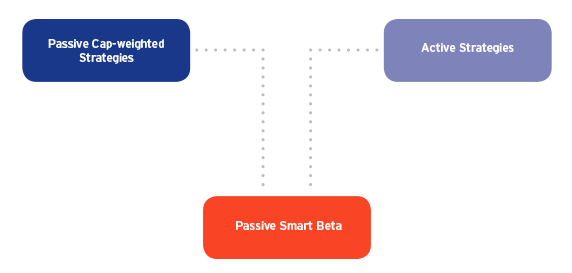SmartBeta ETFs 3 Factors to Calculate Before Adding to a Portfolio
Post on: 13 Июль, 2015 No Comment

Still trying to understand what “smart beta” means for ETFs? Hint: it’s where active meets passive
Three “beta”experts, like Schwab’s Tony Davidow, offer some guidance on “smart-beta” investing.
Smart beta has become the buzzword du jour in the exchange traded fund market as more investors consider straddling the divide between active and passive portfolio management.
Since 2011, dozens of new products that have come to the domestic ETF market can be characterized as smart beta, whether they include words such as volatility, hedged or equal weight in their name. But what does smart beta mean, exactly? And how can advisors determine whether a smart-beta strategy truly reflects a wise investment choice for client portfolios?
Larry Swedroe, director of research with the Buckingham Family of Financial Services and the BAM Alliance and author of The Incredible Shrinking Alpha (BAM Alliance Press, January 2015), believes that much of what is called smart beta is merely marketing-speak because fund companies are chasing a shrinking supply of alpha as markets become more efficient.
Beta represents a portfolios sensitivity to market movements, and it can be used to measure a securitys exposure to risk, Swedroe points out. Beyond that, theres nothing smart about it, he said in a phone interview on Tuesday, asserting that the concept of smart beta comes from active managers who tilt their portfolios away from market risk and toward small and value stocks.
If you construct a value fund with small stocks that kicks out initial public offerings, bankruptcies and small companies that arent profitable, the screening of those duds is smart beta, Swedroe said.
Here are three essential ways to determine how smart-beta ETFs might fit in a client portfolio.
1) Fundamentals Trump Market Cap
Smart-beta indexes tilt toward value stocks that perform well over time, according to Tony Davidow. vice president of alternative beta and asset allocation strategist with the Schwab Center for Financial Research.
The alternative beta investment method for ETFs weights securities based on fundamental factors such as sales, cash flow and dividends plus buyback, Davidow said in a Tuesday phone interview. He said the typical S&P 500 index fund owns all 500 stocks in the index but doesnt invest an equal amount in each. Traditional index fund weights are determined by market capitalization, so that big players, such as Apple Corp. end up comprising a disproportionate share of the fund, he said.
We think of strategic-beta ETFs as fitting into a continuum between traditional market cap strategies and active managers who seek to deliver returns, Davidow said. By definition, theyre not active. Theyre rules-based. The rules are established in advance, and theyre disciplined and founded in academic rigor. An index is unemotional and doesnt alter the strategy based on emotions or current market conditions.
Morningstar Inc. has created taxonomy to categorize smart-beta ETFs, which reached a magnitude of $400 billion in third-quarter 2014 in assets under management, Davidow said.
Like Davidow, Todd Rosenbluth, director of ETF and mutual fund research with S&P Capital IQ, stressed that smart-beta ETFs are rules-based.
These products are a combination of active and passive in that theyre rules-based ETFs that get rebalanced or rejiggered every so often based on criteria of what that ETF is. Typically, theyre a subset of a broader index, Rosenbluth explained in a Tuesday phone interview.
Using the PowerShares S&P 500 ETF (SPLV ) as an example, Rosenbluth said the fund takes the 100 least volatile stocks in the broader S&P 500 index, and then every three months it rebalances by selling what no longer fits its rules-based criteria and buys what does fit. Conversely, he said, the PowerShares S&P 500 High Beta ETF (SPHB ) pulls together the most volatile stocks.
There are new products emerging that allow investors to cater to their investment goals, whether high risk, low risk, dividends or value, Rosenbluth said. In the past, investors used to get these approaches only from a mutual fund.
3) Welcome to Active Management Territory
Although smart-beta ETFs involve indexes, just as all ETFs do, smart-beta ETFs are rules-based, and human beings create those rules. Fallible human beings.
As ETF.com chief investment officer Dave Nadig pointed out in ETF Report: The Smart Beta Trap , when he wrote his article in January last year, the traditionally indexed S&P 500 SPDR ETF (SPY ) was up 26.08% for the trailing 12 months. Only two of 10 selected smart-beta S&P 500 ETFs outperformed SPY: PowerShares S&P 500 High Beta ETF (SPHB ) and Guggenheim S&P 500 Equal Weight (RSP ). PowerShares S&P 500 Buy Write (PBP ) was the poorest performer, at a one-year return of 9.46%.
Perhaps the biggest problem with alternatives to traditional market-cap indexes is that they can lure you into believing you’ve found a better mousetrap, when in fact all you’ve done is found more risk, Nadig wrote.
In other words, theres a reason why passive trumped active investing as measured by inflows and outflows from mutual funds and exchange-traded funds in 2014. Heres how Nadig sums it up: Smart beta, nearly by definition, takes on different risks than plain-old boring market-cap indexes. Anytime you consider a smart-beta product, you have to look hard at how the smart part is affecting the beta part.














